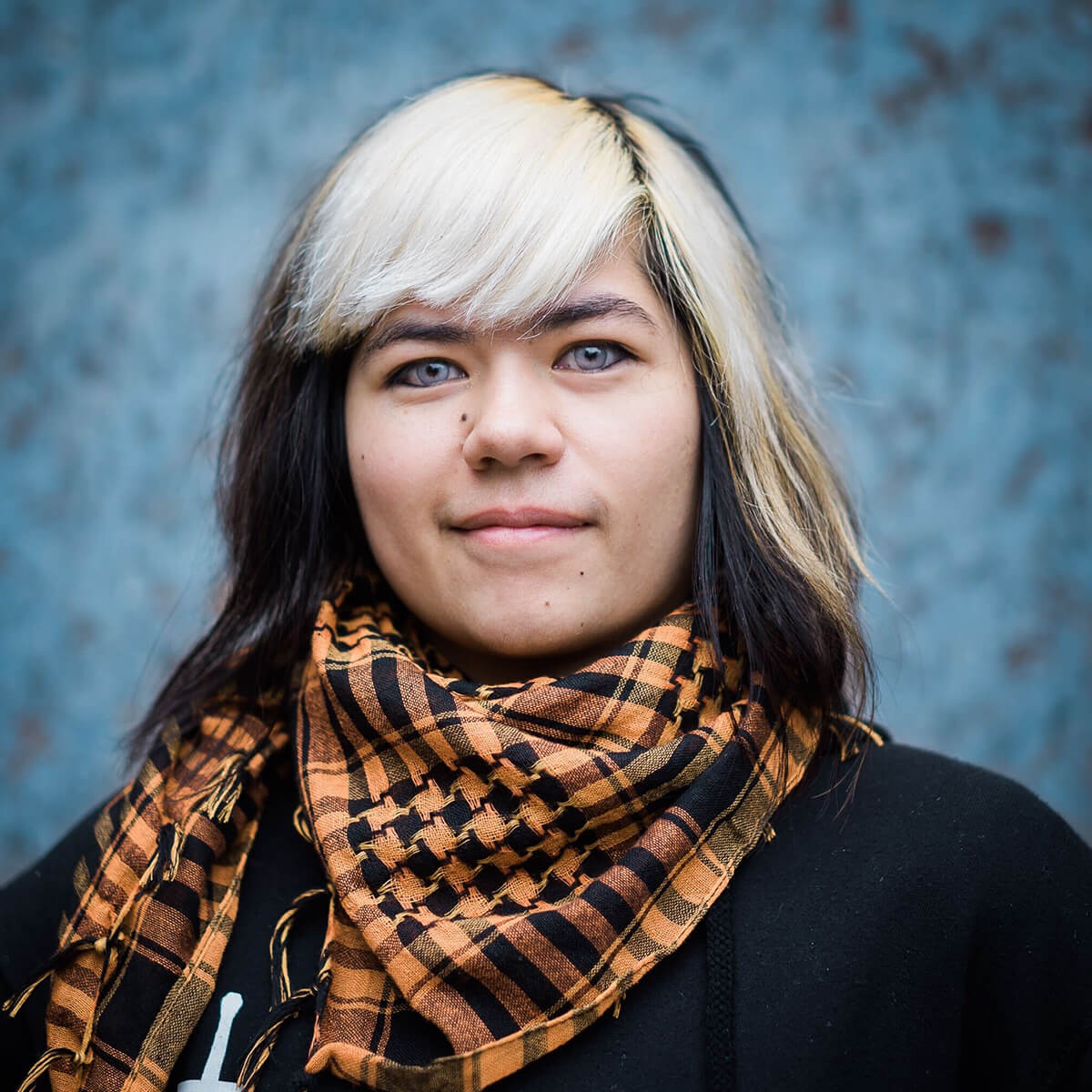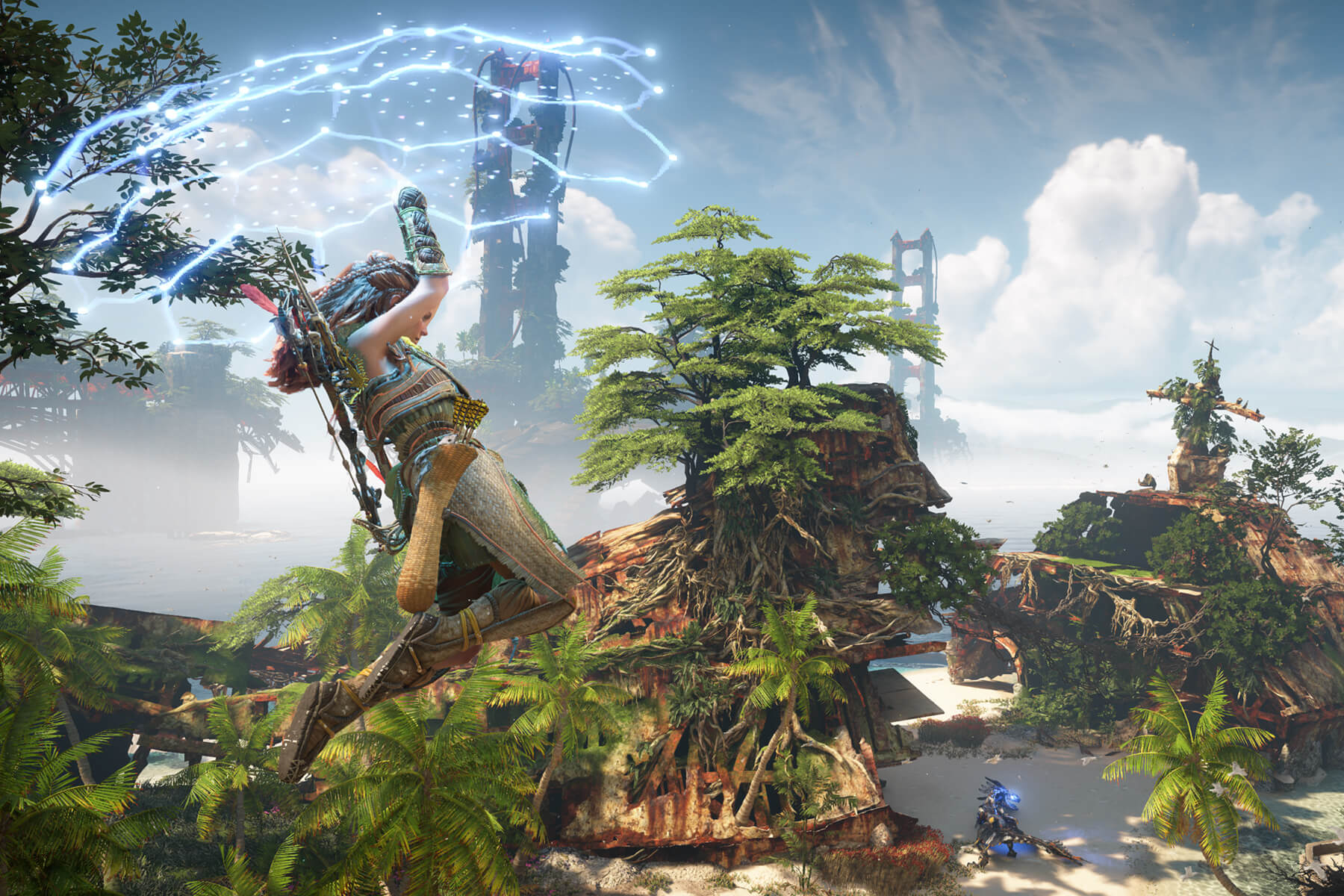When the tulips start blooming, you’ll likely find Idris Grey MacChruiteir zipping around Amsterdam on two wheels. “It’s tough to quantify just how exhilarating it is to bike around in springtime,” MacChruiteir says of her adopted home. “Nearly every random nook in the city is absurdly gorgeous to me.” Whenever MacChruiteir isn’t immersing herself in the beautiful nooks of The Netherlands, she’s chiefly immersed in the post-apocalyptic, machine-infested nooks of the American West. That’s because most of those pleasant bike rides are commutes to Dutch developer Guerrilla Games, where for the last four-and-a-half years, she’s served as a senior quest designer on the PlayStation action RPG, Horizon Forbidden West.

Coincidentally, MacChruiteir’s quest to become a designer began in the pre-apocalyptic American West at DigiPen. A lifelong storyteller, MacChruiteir came to the BA in Game Design program in 2010 with a keen interest in narrative work. “My focus has always been on creating emotionally resonant experiences by finding ways to sync gameplay and narrative, so the player can viscerally experience the game world the way that the playable character does,” MacChruiteir says. Having enrolled before the degree program developed its specialized design concentration tracks, MacChruiteir intentionally made story a core part of her student work, often assuming narrative design roles on her game team projects. “It was on me to set personal sub-objectives within my classes, trying to center my projects on narrative whenever possible,” she says.
After graduating in 2014, she kept that focus at the forefront of her work. At Monolith Productions, where MacChruiteir served as an associate designer on the sandbox team for Middle-earth: Shadow of War, she infused that narrative interest into her primary role, populating the world of Middle-earth outside of game missions. “We didn’t work closely with the narrative team, but I still approached the task with a narrative-first mindset,” MacChruiteir says. “I endeavored to create AI vignettes that made sense, like having orcs training Caragors, or carrying meat out of the forest in Núrn.” When she saw a quest designer opening in Amsterdam at Guerrilla Games, she leapt at the opportunity. “The position felt like a more direct manifestation of my internal trajectory, so I applied for the role as soon as I saw it!” she says.
The studio couldn’t have been a better fit given the deep narrative focus of the Horizon series. Set in a ruinous 31st century America strewn with primitive human tribes and vicious robotic creatures, the series follows Aloy, a warrior thrust into the mystery of how the world came to be this way. MacChruiteir joined Guerrilla Games shortly after the series’ bestselling 2017 debut, Horizon Zero Dawn, hit the PlayStation 4, quickly getting to work on its direct sequel, Horizon Forbidden West.
“The quest team at Guerrilla is a bit unique in that we own a breadth of design for our quests,” MacChruiteir says. “We’re narrative designers, and level designers, and encounter designers.” MacChruiteir and the quest team work closely with the writing team, who primarily develop the game’s story beats. “Quest is responsible for translating those beats into gameplay,” MacChruiteir says. “When it’s time to start building, we meet with the writer assigned to the quest to discuss ideas and ensure we’re both aligned with our scope and goals. It’s a hand-in-hand collaboration from start to finish, and there’s plenty of give and take from both sides.”

While MacChruiteir did design a handful of side quests and errands, her primary focus was on an area called The Base. Unlocked after completing a main quest that MacChruiteir built, The Base becomes a central camp for Aloy and her companions during the game, one players will return to often throughout the rest of their adventure. “I did a lot of research, pitching, layout design, iteration, and collaboration with other teams to populate the space,” MacChruiteir says.
One of the greatest challenges of MacChruiteir’s job is also one of the game’s most celebrated features — its vast open world. Players can complete most of the game’s main quests in any order they want. Those quests often start and end at The Base, affecting the features and characters within it along the way. “The Base was more of a feature than a quest, and it required a much more intensive level of inter-department syncing,” MacChruiteir says. At times, that meant working alongside other quest designers to ensure all of the overlapping Base-related quest content functioned as intended. It also meant having to implement highly intricate companion conversations, based on a complex web of conditional variables. “There were many more vectors to consider and many more people to keep in the loop than there normally would be for a quest,” she says.
All that hard work has turned into a high point for MacChruiteir now that the game has shipped. “I’d like to give a huge shout out to the other Guerrillas that worked on The Base,” she says. “They all poured their heart and soul into coming together and realizing our shared vision for the space.” Critics have given plenty of shout outs to the “Guerrillas” too, with Polygon calling the game “breathtaking” and Thrillist naming it “a next-gen open-world masterpiece.”
“We accomplished something pretty hecking good, all while under the unforeseen strain of a global pandemic,” MacChruiteir says. “One of the earliest lessons I learned at DigiPen was that it’s hard to ever feel a project is truly finished. There’s always more to fix and polish. Despite that, I’m incredibly proud of what we accomplished.”
MacChruiteir attributes a number of lessons learned at DigiPen to her success in the industry. “DigiPen’s project-focused curriculum was super useful in preparing me for the industry,” she says. “Having to build so many games as a student, both on my own and in teams, gave a decent impression of what actually working in the industry would be like.” One particular teacher, former DigiPen instructor James Portnow, had an especially big impact on MacChruiteir’s craft. “He showed me how to start thinking like a designer, and he had a knack for encouraging my strengths and suggesting ways to improve my weaknesses,” MacChruiteir says. “I knew going into DigiPen that I loved video games, but he helped me discover how much I love game design, and for that I’ll be forever grateful.”
